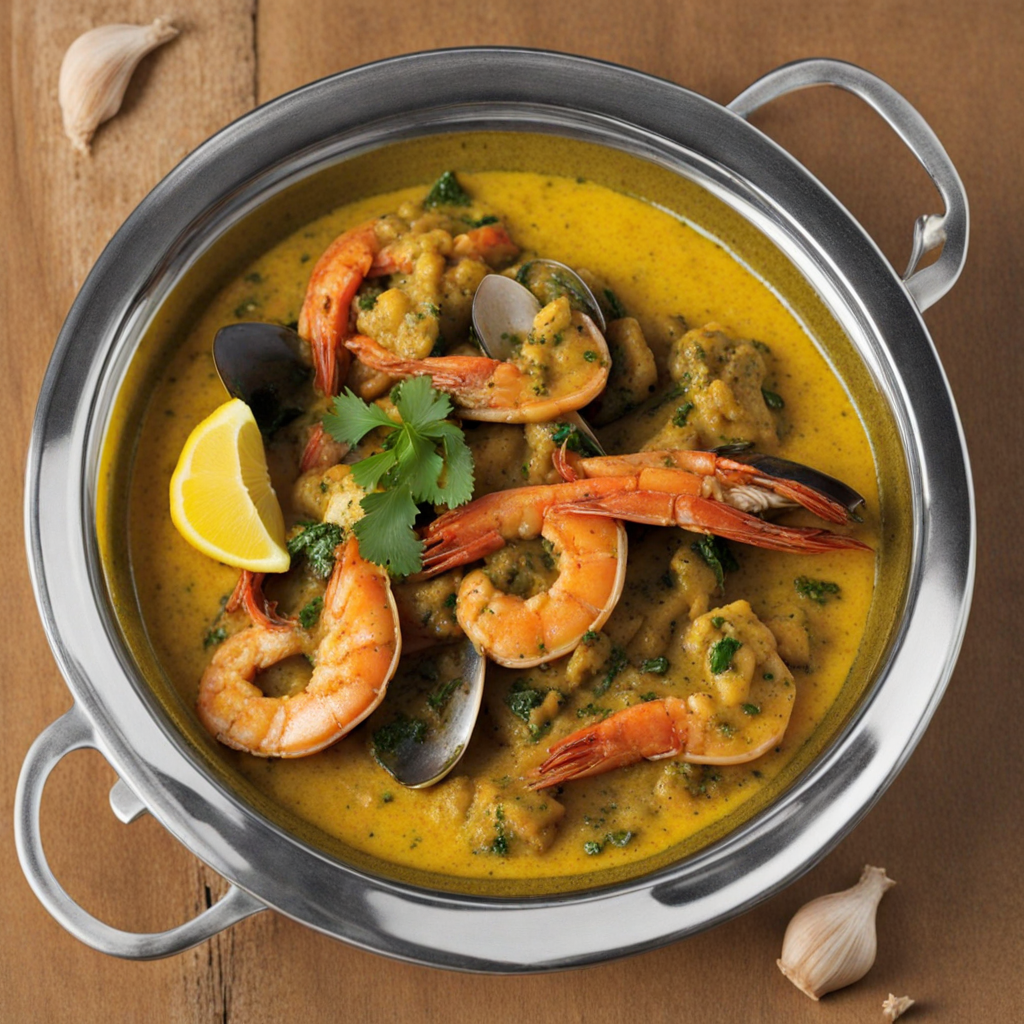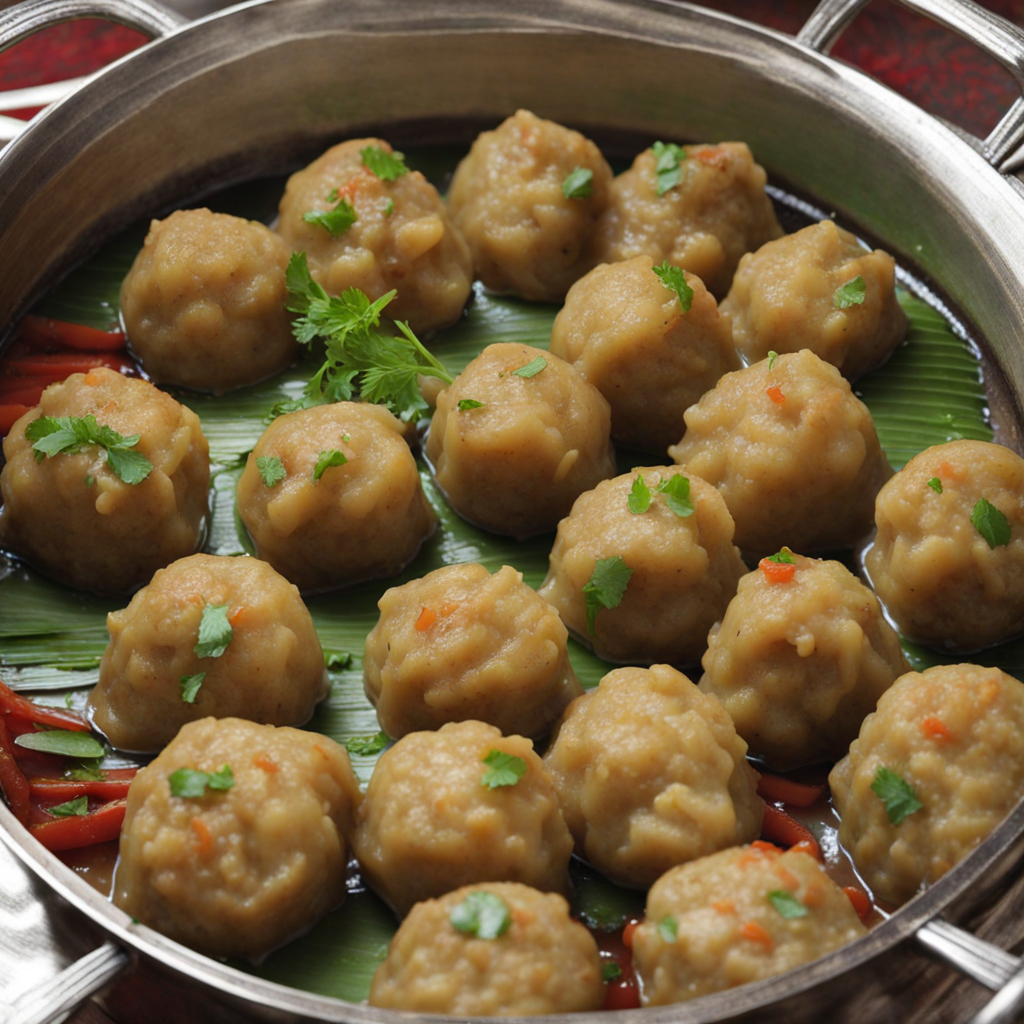Seafood Vindaye
Seafood Vindaye is a tantalizing dish that embodies the vibrant culinary heritage of Mauritius, a tropical paradise in the Indian Ocean. This dish is a beautiful fusion of fresh seafood, typically fish or prawns, marinated in a spicy blend of mustard seeds, turmeric, garlic, and vinegar, which imparts both zest and depth of flavor. The marination process allows the seafood to absorb the aromatic spices, creating a dish that is rich in taste yet refreshingly tangy. The combination of spices not only elevates the natural sweetness of the seafood but also brings a delightful warmth that dances on the palate. Once marinated, the seafood is gently sautéed, allowing it to retain its tenderness while developing a slightly crispy exterior. The addition of caramelized onions, green chilies, and fresh coriander enhances the overall flavor profile, lending a hint of earthiness and brightness. Served with steamed rice or flatbreads, Seafood Vindaye becomes a comforting yet exotic meal that transports you straight to the shores of Mauritius with each bite. This dish is often enjoyed as part of a larger spread during family gatherings or special occasions, showcasing the communal spirit of Mauritian dining. Its unique blend of flavors, balancing spicy, tangy, and savory notes, makes Seafood Vindaye a must-try for adventurous eaters seeking to explore the culinary treasures of this island nation. Whether you are a seafood lover or simply in search of new taste experiences, Seafood Vindaye is sure to leave an unforgettable impression.
How It Became This Dish
The Culinary Journey of Vindaye Poisson: Mauritius' Flavorful Legacy #### Origins and Historical Context Vindaye Poisson, a beloved dish from Mauritius, reflects the island's rich tapestry of cultural influences and culinary traditions. This vibrant fish dish, characterized by its tangy and spicy marinade, is a testament to the island's history of colonization, migration, and the confluence of diverse culinary practices. Mauritius, situated in the Indian Ocean, has been shaped by the influences of several cultures, including African, Indian, French, and Chinese, owing to its colonial past. The island was first inhabited by the Dutch in the 17th century but was later colonized by the French in the 18th century, followed by British rule in the 19th century. Each of these colonial powers left a mark not just on the island's governance but also on its cuisine. The origins of Vindaye Poisson can be traced back to the French settlers who brought with them their culinary techniques and flavors. The word "vindaye" is believed to be derived from the French word "vinaigre," which means vinegar, a key ingredient in the dish. This reflects the French influence on Mauritian cuisine, where the use of vinegar and spices is prevalent. #### Ingredients and Preparation Vindaye Poisson typically features fresh fish, often marinated in a mixture of vinegar, turmeric, garlic, ginger, and various spices. The fish, usually a firm white fish such as snapper or grouper, is cut into pieces and marinated for several hours, allowing the flavors to penetrate the flesh. After marination, the fish is often pan-fried until golden brown, then tossed with sautéed onions and additional spices, creating a flavorful sauce that clings to the fish. One of the unique aspects of Vindaye Poisson is its use of mustard seeds, which are toasted and ground to release their aromatic oils, contributing a distinctive flavor profile. This ingredient is a nod to the Indian influence on Mauritian cooking, as mustard seeds are commonly used in Indian cuisine. #### Cultural Significance Vindaye Poisson is not just a dish; it is an integral part of the Mauritian identity. It embodies the island's multicultural society, where various culinary traditions coexist harmoniously. The preparation and consumption of Vindaye Poisson often occur during family gatherings, festivals, and communal meals, making it a symbol of togetherness and celebration. In Mauritian households, food is a means of expressing love and hospitality. Preparing Vindaye Poisson can be a communal activity, with family members gathering in the kitchen to help with marination and cooking. The dish is often served alongside rice and lentils, making it a hearty and satisfying meal that reflects the island's agricultural bounty. #### Development Over Time As Mauritius evolved through the decades, so did its culinary landscape. The introduction of new ingredients and cooking techniques transformed traditional dishes, and Vindaye Poisson was no exception. With the advent of globalization and increased access to international markets, chefs and home cooks began experimenting with the dish, incorporating local and seasonal ingredients. In the 20th century, the rise of tourism in Mauritius played a significant role in the evolution of Vindaye Poisson. As visitors from around the world arrived on the island, they brought with them diverse palates and culinary expectations. This led to a fusion of flavors, with chefs adding innovative twists to traditional recipes to cater to international tastes. Some modern interpretations of Vindaye Poisson may include the addition of tropical fruits, such as mango or passion fruit, to enhance the dish's flavor and visual appeal. The dish's popularity has also spurred the emergence of food festivals dedicated to showcasing Mauritian cuisine. Events such as the "Mauritius Food Festival" celebrate local dishes, including Vindaye Poisson, allowing chefs to showcase their creativity while honoring traditional recipes. These festivals serve as a platform for cultural exchange and appreciation, attracting both locals and tourists alike. #### Vindaye Poisson in Contemporary Cuisine Today, Vindaye Poisson holds a special place in the hearts of Mauritians and food enthusiasts around the world. It is often featured in restaurants that specialize in Creole cuisine, showcasing the island's culinary heritage. Chefs take pride in preparing Vindaye Poisson with the freshest local fish and traditional spices, ensuring that each dish reflects the authenticity of Mauritian cooking. Moreover, the globalization of culinary culture has led to an increased interest in Mauritian cuisine. Food bloggers and culinary influencers have highlighted Vindaye Poisson, sharing recipes and cooking tips online. This surge in interest has not only revived traditional cooking methods but has also sparked a renewed appreciation for the island's culinary heritage among younger generations. In Mauritius, Vindaye Poisson is often enjoyed as a comfort food, evoking memories of family meals and gatherings. It is a dish that transcends generations, with each family passing down its unique recipe and preparation methods, thus preserving the cultural significance of the dish. #### Conclusion Vindaye Poisson is more than just a dish; it is a reflection of Mauritius' history, culture, and social fabric. It embodies the island's diverse heritage, showcasing the harmonious blend of flavors and techniques from various culinary traditions. As Mauritius continues to evolve, Vindaye Poisson remains a cherished symbol of the island's identity, connecting people through the shared experience of food. In an ever-changing world, Vindaye Poisson serves as a reminder of the importance of cultural heritage and culinary traditions. Its journey from the kitchens of colonial settlers to contemporary dining tables is a testament to the resilience and adaptability of Mauritian cuisine. As this dish continues to delight palates and bring people together, it stands as a flavorful legacy of Mauritius' rich culinary history.
You may like
Discover local flavors from Mauritius







